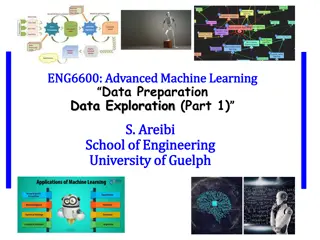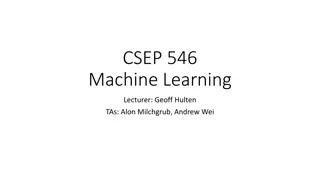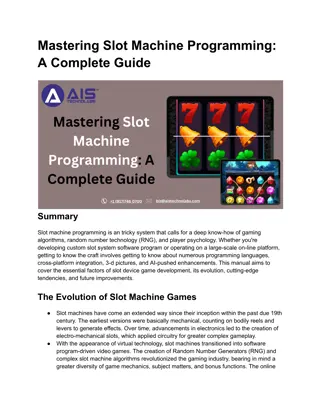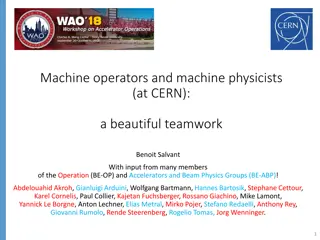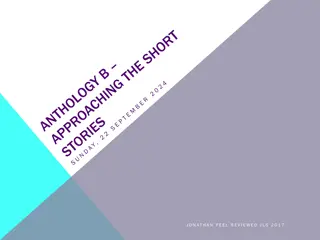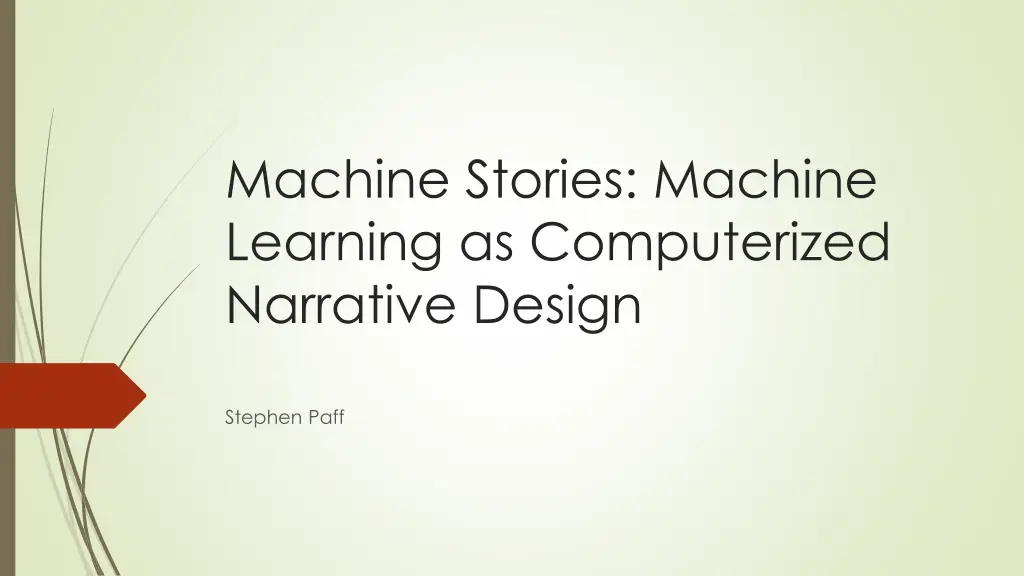
Understanding Machine Learning Through Emergence and Narratives
Explore the intersection of machine learning, emergence, and narrative design as a key to understanding complex systems in computer science. Delve into the essence of machine learning algorithms as social agents within narrative structures. Witness the evolution of emergent software systems through iterative data analysis and adaptive relationships, all facilitated by the principles of cybernetics.
Uploaded on | 0 Views
Download Presentation

Please find below an Image/Link to download the presentation.
The content on the website is provided AS IS for your information and personal use only. It may not be sold, licensed, or shared on other websites without obtaining consent from the author. If you encounter any issues during the download, it is possible that the publisher has removed the file from their server.
You are allowed to download the files provided on this website for personal or commercial use, subject to the condition that they are used lawfully. All files are the property of their respective owners.
The content on the website is provided AS IS for your information and personal use only. It may not be sold, licensed, or shared on other websites without obtaining consent from the author.
E N D
Presentation Transcript
Machine Stories: Machine Learning as Computerized Narrative Design Stephen Paff
Machine Learning Formal definition of Machine Learning: Learning denotes changes in the system that are adaptive in the sense that they enable the system to do the task or tasks drawn from the same population more efficiently and more effectively the next time (Simon). In short, machine learning refers to: An algorithm which learns by developing its own way to analyze data (in the same or new context) through adapting over iterations
Shift in Relationship in Computer Science Traditional Programming Requirements Data Output Program Human Computer Machine Learning Input Machine Learning (guidelines) Requirements Data Output Program Computer Input Human
Thesis Two Arguments: 1. We need to use emergence to understand machine learning systems 2. To do this, we must analyze machine learning algorithms as: 1. Social agents 2. Functioning within narrative structures
Argument 1: We need to use emergence to understand machine learning systems. Two types of emergence: 1. Weak: Machine learning algorithms are a low-level emergent entity 2. Complicated: The overall human-software systems in which they exist become have even greater potential for emergence
Iterating over Data At the most basic level, machine learning algorithms: 1. Refine the parameters used to model the behavior 2. By iterating over data, tweaking the parameters 3. In order to improve accuracy Through these, a model to analyze the data emerges.
Emergent Software Systems Machine learning algorithms are typically an important part of an overall system of different programs. Through their interaction with other software systems and humans, more complicated structures emerge exhibiting even more complicated behavior.
Cybernetics and Machine Learning Cybernetics is the best tool to conceptualize and facilitate the development of these emergent systems. Machine learning involves adaptive relationships to build intelligence based on observations. Yet, they are an extremely weak version of this.
Argument 2: To see them as emergent, we must understand machine learning algorithms as: 1. Social agents 2. Functioning within narrative structures
Social Agent Definition Social: Interactive, interacts in a web of relationships with other entities (not just humans) Agency: The ability to influence other entities Thus a social agent interacts with other entities in a web of relationships, influencing them and being influenced in the process
Non-Human Agency Within a constructionist framework, two broad examples of non-human agents: 1. Material things/entities (e.g. Latour s actor-network theory, object-oriented ontology) 2. Social processes/structures (e.g. Foucault s work) But machine learning algorithms straddle both. .
Narrative Structures Structure: A process or set of rules whether strict or fluid which form a system Narrative Structure: A structure which facilitates some kind of transformation for an agent(s) in the system overtime Machine learning algorithms are themselves narrative structures. The wider human-computer systems in which they exist are also narrative structures These narrative structures are agents.
Conclusion: In cybernetics, we need to use emergence to help computer scientists understand/develop machine learning systems. This requires viewing these systems as social agents functioning within narrative structures.
Image Sources The images are from the following sources (in order of usage in slides): 1. Slide taken from presentation by Deepak Venugopal, with my own minor modifications 2. https://towardsdatascience.com/what-the-hell-is-perceptron-626217814f53 3. https://www.cleveroad.com/blog/importance-of-machine-learning- applications-in-various 4. https://sociable.co/technology/5-facts-machine-learning-ai/
Bibliography: For my Bibliography (in Google Drive), go to the following link: https://bit.ly/2uBMlrD







